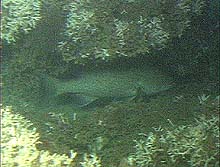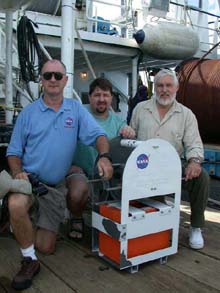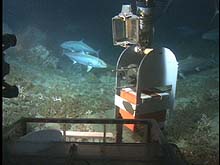
Scientists hope to learn more about certain fish species, such as this gag grouper at Jeff's Reef on Oculina Bank, by listening to them during the February-April spawning season. Click image for larger view.
Acoustic Monitoring of Grouper Spawning on the Oculina Bank
September 1, 2001
R. Grant Gilmore, Jr., PhD, Michael Lane, and Steven Van Meter
Kennedy Space Center, Florida
![]() View a video of the deployment of an underwater listening device. (3.4 MB, QuickTime
View a video of the deployment of an underwater listening device. (3.4 MB, QuickTime ![]() required).
required).
Background
Some 25 yrs ago, a series of submarine dives on the Oculina coral reefs off Florida documented the spawning activities of two important fishery species, the gag grouper (Mycteroperca microlepis) and the scamp grouper (M. phenax). We had discovered their spawning site. Myriads of other species were present, including warsaw and snowy groupers, speckled hind and black seabass, as well as blue angelfish, bar drum, and large schools of basslets, amberjack, and little tunny. The most studied site was dubbed Jeff's Reef, after the man who was piloting the sub when we discovered the coral reef. Jeff's Reef was the most spectacular of all the reefs along the coast,as it had large, pristine coral heads over its entire area. This was in contrast to reefs further north, which had largely been reduced to coral rubble by some unknown force. These latter reefs did not support spawning populations of groupers; only live coral reefs, such as Jeff's Reef, do.
Spawning Behavior
Our early objectives were to document the behavior and color changes when male and female groupers interacted before, during, and after mating. They change colors dramatically within seconds, so underwater videos were made of their behavior. Since the two species we were studying change sex from female to male and the males protect territories and harems, we needed to document color phases that indicated male dominance, female hierarchies, and male interactions. We also wanted to determine if there were preferred mating sites, and the degree of association between the groupers and specific sites on the reef. During this early work, we also noted that the groupers
produced sounds during their interactions. The mother ship hovering above the submarine made too much noise, however, for us to make adequate recordings of diagnostic grouper sounds.

Ocean scientists Steven Van Meter, Michael Lane, and Dr. Grant Gilmore with the Passive Acoustic Monitoring System (PAMS) deployed on the Oculina Bank leg of the Islands in the Stream-South Atlantic Bight mission. The device, battery, and housing weigh about 160 lbs topside. Click image for larger view.
The Sounds of Spawning
Groupers and other fishes produce sounds using their mouths, gill covers, teeth, fins, and the muscles attached to an internal gas bladder. They can vibrate the walls of their air bladder like a drum. Most fish produce sounds that are distinct to the species; groupers, for example, produce very low- pitched grunting sounds. Thus, if you hear the sound and recognize it, you can tell which grouper species produced it. Most fish produce sound only when they mate or spawn. This means that if you hear the sound of a gag grouper, it is most likely a male producing his sound to stimulate a female to spawn. Therefore, the sound not only means that the gag or scamp is present, but also that they are attempting to spawn.
The fishes most intensely studied by our group are the drum, sea trout and croaker family, which, in most cases, form a choir of calling males attempting to attract silent females (which typically cannot produce sound) to a specific spawning site at sunset. We were able to use the species-specific male choirs to map spawning activities in time and space. We know that groupers do not form groups of calling males. In contrast, male groupers each jealously protect a territory and 10-15 females within a harem. A single male grouper will isolate a female and swim beside her, making low-pitched grunting sounds. We have observed and recorded this behavior in Nassau groupers (Epinephelus striatus). Therefore, we expect to record a series of single calls at Jeff's Reef when gag and scamp meet to spawn, most likely at sunset.
Listening to Fish and Vessel Sounds
The objective of our present mission is to deploy NASA prototype underwater equipment, called the Passive Acoustic Monitoring System (PAMS), at the historical grouper spawning site on Jeff's Reef. (![]() View a short video of deploying a prototype PAMS on this mission.) We will also be recording grouper behavior by quietly settling the submarine on the bottom after deploying the NASA PAMS. We will pan and tilt a low-light video camera around the acoustic arena to document all fish species at the recording site. The PAMS will record all sounds produced on the reef for 48 hrs. After sitting on the bottom for 48 hrs, the PAMS will be retrieved and its acoustic data downloaded for sound analyses. We hypothesize that distinct sounds will be obtained, which we will be able to attribute to the scamp and gag groupers, as well as other sound-producing fishes on this reef formation. We also should be able to determine the time of day that sound is most likely to be recorded. We will also be able to hear any boating activity in the area, as sound carries five times faster and further underwater than in air. Since Jeff's Reef is within a protected reserve where bottom fishing is not allowed, it will be interesting to see if we can tell from recorded sounds whether boats stop or anchor on this protected reef during our study.
View a short video of deploying a prototype PAMS on this mission.) We will also be recording grouper behavior by quietly settling the submarine on the bottom after deploying the NASA PAMS. We will pan and tilt a low-light video camera around the acoustic arena to document all fish species at the recording site. The PAMS will record all sounds produced on the reef for 48 hrs. After sitting on the bottom for 48 hrs, the PAMS will be retrieved and its acoustic data downloaded for sound analyses. We hypothesize that distinct sounds will be obtained, which we will be able to attribute to the scamp and gag groupers, as well as other sound-producing fishes on this reef formation. We also should be able to determine the time of day that sound is most likely to be recorded. We will also be able to hear any boating activity in the area, as sound carries five times faster and further underwater than in air. Since Jeff's Reef is within a protected reserve where bottom fishing is not allowed, it will be interesting to see if we can tell from recorded sounds whether boats stop or anchor on this protected reef during our study.

The PAMS, in its mailbox-shaped housing, is retrieved by the robotic arm (top) of the Clelia submersible. The listening device is the gray, cylindrical instrument above the orange-colored battery. Amberjack swim in the background. Click image for larger view.
In the case of Oculina Bank, where there is concern that fishing activities have seriously damaged the Oculina coral heads, a serious need exists for a habitat map and quantitative assessments of the extent of the coral. During this mission, ROV and manned submersibles will complement each other in the quest to understand exactly how much Oculina coral remains on the bank. ROV operations will provide scientists with a relatively rapid reconnaissance and assessment of the types of bank habitats. This information will allow them to better direct the precise locations for HOV operations, where the distribution and abundance of Oculina can be studied and quantified. The scientists on this expedition are playing on the strengths of both types of technology.
If the PAMS is successful in documenting the species-specific calls of groupers and also in detecting human activities within the Oculina Research Reserve, our research will lead the way for the use of remote, in-situ sensing technologies to monitor fish and human activities in marine protected areas (MPAs) elsewhere in the United States. Presently, it is extremely difficult to determine the activities of fish and fishermen in MPAs, mostly due to the difficulty in remaining at sea for prolonged periods of time. Future studies and technologies may allow continuous passive observations of both marine organisms (e.g., fish, invertebrates, whales) and people, so that we will finally begin to understand their behavior and how they react to one another.
Retrieving the Hydrophone
Yesterday, the Clelia dove to Jeff's Reef in the late afternoon and retrieved the PAMS with one of its robotic arms. Scientists plan to conduct further tests on the prototype listening device in the Gulf of Mexico and off the coast of Cape Canaveral. They plan to redeploy the device on Oculina Bank during grouper spawning season, and will also listen in on speckled hind, another species that has drastically declined on the Bank. Eventually, researchers hope to deploy multiple devices on the Bank to precisely determine the location of fish sounds.
Sign up for the Ocean Explorer E-mail Update List.











































